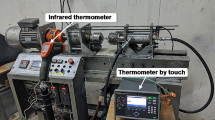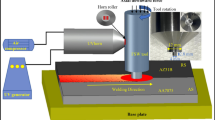Abstract
Joining procedure for aluminum alloy 7075-T6 (AlZnMgCu1.5) sheets was realized by impulse friction stir welding (IFSW) with different impulse frequencies. The additional mechanical impulses during IFSW enhance the forging action of the tool, resulting in the weld microstructure modification. The microstructural evolution in different zones of the weld (SZ and HAZ) was studied, focusing on the strengthening precipitation behavior of the welded joint as well as the overall mechanical properties. The results illustrate that the application of impulses during IFSW in SZ of the weld accelerates the reprecipitation and dynamic recrystallization processes, which lead to the formation of strengthening precipitates and the homogeneous grain microstructure, respectively. HAZ of the welds obtained by the FSW and IFSW represent dislocation-free grain interior, and the strengthening precipitation behavior was completely different: the HAZ of conventional FSW welds exhibits a high concentration of stable η phase, while in the HAZ of IFSW joints shows a high concentration of heat-sensitive η' precipitates, suggesting that even in the HAZ, only additional deformation generated by mechanical impulses even in HAZ is responsible for the induced formation of GP zones and after the transformation of GP zones to the metastable η' precipitates.

















Similar content being viewed by others
References
Yang Y, Tan P, Sui Y, Jiang Y, Zhou R (2021) Influence of Zr content on microstructure and mechanical properties of As-cast Al-Zn-Mg-Cu alloy. J Alloys Compd 867:158920. https://doi.org/10.1016/j.jallcom.2021.158920
Brotzu A, De Lellis G, Felli F, Pilone D (2017) Study of defect formation in Al 7050 alloys. Procedia Struct Integr 3:246–252. https://doi.org/10.1016/j.prostr.2017.04.015
Zhou Bo, Liu Bo, Zhang S (2021) The Advancement of 7XXX Series Aluminum Alloys for Aircraft Structures: A Review. Metals 11:718. https://doi.org/10.3390/met11050718
Li Bo, Wang X, Chen H, Jie Hu, Huang C, Guo G (2016) Influence of heat treatment on the strength and fracture toughness of 7N01 aluminum alloy. J Alloys Compd 678:160–166. https://doi.org/10.1016/j.jallcom.2016.03.228
Zhao J, Liu Z, Bai S, Zeng D, Luo L, Wang J (2020) Effects of natural aging on the formation and strengthening effect of G.P. zones in a retrogression and re-aged Al-Zn-Mg-Cu alloy. J Alloys Compd 829:154469. https://doi.org/10.1016/j.jallcom.2020.154469
Zuo J, Hou L, Shu X, Peng W (2020) Grain refinement assisted by deformation induced precipitates through thermomechanical treatment of AA7055 Al Alloy. Metals 5:725–732. https://doi.org/10.3390/met10050594
Ma K, Wen H, Tao Hu et al (2014) Mechanical behavior and strengthening mechanisms in ultrafine grain precipitation-strengthened aluminum alloy. Acta Mater 62:141–155. https://doi.org/10.1016/j.actamat.2013.09.042
Jacumasso SC, de Paula J, Martins AL, de Carvalho M (2016) Analysis of precipitate density of an aluminium alloy by TEM and AFM. Metall Mater 69:451–457. https://doi.org/10.1590/0370-44672016690019
Huang R, Li M, Yang H et al (2022) Effects of Mg contents on microstructures and second phases of as-cast Al–Zn–Mg–Cu alloys. J Mater Res Technol 21:2105–2117. https://doi.org/10.1016/j.jmrt.2022.10.050
Lezaack MB, Simar A (2021) Avoiding abnormal grain growth in thick 7XXX aluminum alloy friction stir welds during T6 post heat treatments. Mater Sci Eng A 807:140901. https://doi.org/10.1016/j.msea.2021.140901
Wahid MA, Siddiquee AN (2018) Review on underwater friction stir welding: A variant of friction stir welding with great potential of improving joint properties. Trans Nonferrous Met Soc China 28:193–219. https://doi.org/10.1016/S1003-6326(18)64653-9
Meng X, Huang Y, Cao J, Shen J, dos Santos JF (2021) Recent progress on control strategies for inherent issues in friction stir welding. Prog Mater Sci 115:100706. https://doi.org/10.1016/j.pmatsci.2020.100706
Upadhyay P, Reynolds AP (2010) Effects of thermal boundary conditions in friction stir welded AA7050-T7 sheets. Mater Sci Eng A 527:1537–1543. https://doi.org/10.1016/j.msea.2009.10.039
Ren SR, Ma ZY, Chen LQ (2008) Effect of initial butt surface on tensile properties and fracture behavior of friction stir welded Al–Zn–Mg–Cu alloy. Mater Sci Eng A 479:293–299. https://doi.org/10.1016/j.msea.2007.06.047
Rui-dong Fu, Sun Z-Q, Sun R-C, Li Y, Liu H-J, Liu L (2011) Improvement of weld temperature distribution and mechanical properties of 7050 aluminum alloy butt joints by submerged friction stir welding. Mater Des 32:4825–4831. https://doi.org/10.1016/j.matdes.2011.06.021
Sivaraj P, Seeman M, Seetharaman R, Balasubramanian V (2021) Fracture toughness properties and characteristics of Friction stir welded high strength aluminium alloy by post weld heat treatment (PWHT). Mater Today Proc 43:2150–2155. https://doi.org/10.1016/j.matpr.2020.11.998
Heinz B, Skrotzki B (2002) Characterization of a Friction-Stir-Welded Aluminum Alloy 6013. Metall Mater Trans B 33:489–498. https://doi.org/10.1007/s11663-002-0059-5
Zhang C, Huang G, Zhang D, Sun Z, Liu Q (2020) Microstructure and mechanical properties in dissimilar friction stir welded AA2024/7075 joints at high heat input: effect of post-weld heat treatment. J Mater Res Technol 9:14771–14782. https://doi.org/10.1016/j.jmrt.2020.10.053
El-Danaf EA, El-Rayes MM (2013) Microstructure and mechanical properties of friction stir welded 6082 AA in as welded and post weld heat treated conditions. Mater Des 46:561–572. https://doi.org/10.1016/j.matdes.2012.10.047
Dong P, Li H, Sun D, Gong W, Liu J (2013) Effects of welding speed on the microstructure and hardness in friction stir welding joints of 6005A–T6 aluminum alloy. Mater Des 45:524–531. https://doi.org/10.1016/j.matdes.2012.09.040
Rodrigues DM, Leitão C, Louro R, GouveiaI H, Loureiro A (2010) High speed friction stir welding of aluminium alloys. Sci Technol Weld Joi 15:676. https://doi.org/10.1179/136217110X12785889550181
Liu H, Liu X, Wang X, Wang T, Yang Si (2017) Mechanical properties and their relations to microstructural characteristics of high-speed friction stir-welded AA6005A-T6 aluminum hollow extrusions. Int J Adv Manuf Tech 88:3139–3149. https://doi.org/10.1007/s00170-016-9032-3
Zhang J, Upadhyay P, Hovanski Y, David P (2018) Field, High-Speed Friction Stir Welding of AA7075-T6 Sheet: Microstructure, Mechanical Properties, Micro-texture, and Thermal. Metall Mater Trans A 49:210–222. https://doi.org/10.1007/s11661-017-4411-4
Liu F, LiFu HC (2018) High speed friction stir welding of ultra-thin AA6061-T6 sheets using different backing plates. J Manu Process 33:219–227. https://doi.org/10.1016/j.jmapro.2018.05.020
Wang Q, Zhao Z, Yan K (2015) The adjustment strategy of welding parameters for spray formed 7055 aluminum alloy underwater friction stir welding joint. Mater Des 88:1366–1376. https://doi.org/10.1016/j.matdes.2015.09.038
Zhao Y, Wang Q, Chen H, Yan K (2014) Microstructure and mechanical properties of spray formed 7055 aluminum alloy by underwater friction stir welding. Mater Des 1980–2915(56):725–730. https://doi.org/10.1016/j.matdes.2013.11.071
Tarasov SY, Rubtsov VE, Fortuna SV et al (2017) Ultrasonic-assisted aging in friction stir welding on Al-Cu-Li-Mg aluminum alloy. Weld World 61:679–690. https://doi.org/10.1007/s40194-017-0447-8
Michailov VP (1999) Impuls-Rührreibschweißen (Impulse Friction Stir Welding). Cottbus, Germany
Morozova I, Obrosov A, Naumov A et al (2021) Impact of impulses on microstructural evolution and mechanical performance of Al-Mg-Si alloy joined by impulse friction stir welding. Mater 14:347–362. https://doi.org/10.3390/ma14020347
AlaliAlkhalaf A, Tesleva A, Polyakov P et al (2021) Modified Friction Stir Welding of Al–Zn–Mg–Cu Aluminum Alloy. In: Hovanski Y, Sato Y, Upadhyay P, Naumov AA, Kumar N (eds) Friction Stir Welding and Processing XI The Minerals, Metals & Materials Series. Springer, Cham, pp 43–51. https://doi.org/10.1007/978-3-030-65265-4_5
Kondrat’ev SY, Morozova YN, Golubev YA et al (2018) Microstructure and Mechanical Properties of Welds of Al – Mg – Si Alloys After Different Modes of Impulse Friction Stir Welding. Met Sci Heat Treat 56:697–702. https://doi.org/10.1007/s11041-018-0213-6
Rometsch PA, Zhang Y, Knight S (2014) Heat treatment of 7xxx series aluminium alloys—Some recent developments. Trans Nonferrous Met Soc China 24:2003–2017. https://doi.org/10.1016/S1003-6326(14)63306-9
Chayang S, Atkinson HV, Kapranos P (2004) Multistep induction heating regimes for thixoforming 7075 aluminium alloy. Mater Sci Technol 20:490–496. https://doi.org/10.1179/026708304225012341
Prasad NE, Ramachandran TR (2014) Chapter 3 - Phase Diagrams and Phase Reactions in Al–Li Alloys. In: Prasad NE, Gokhale AA, Wanhill RJH (eds) Aluminum-Lithium Alloys, Butterworth-Heinemann, Boston, pp 61–97. https://doi.org/10.1016/B978-0-12-401698-9.00003-3
Farzadi A (2017) Correlation between precipitate microstructure and mechanical properties in AA7075-T6 aluminum alloy friction stir welded joints. Mater Sci Eng Technol 48:151–162. https://doi.org/10.1002/mawe.201700505
Golubev I, Morozova I, Naumov A et al (2017) Numerical simulation and experimental investigation on impulse friction stir welding of 6082-T6 aluminum alloy. In: Materials Science and Technology 2017 (MS&T17) Conference, Pittsburgh, USA. pp 987–994. https://doi.org/10.7449/2017/mst_2017_987_994
Olea CAW, Roldo L, dos Santos JF, Strohaecker TR (2007) A sub-structural analysis of friction stir welded joints in an AA6056 Al-alloy in T4 and T6 temper conditions. Mater Sci Eng A 454–455:52–56. https://doi.org/10.1016/j.msea.2006.12.055
Xu WF, Luo YX, Fu MW (2018) Microstructure evolution in the conventional single side and bobbin tool friction stir welding of thick rolled 7085–T7452 aluminum alloy. Mater Charact 138:48–55. https://doi.org/10.1016/j.matchar.2018.01.051
Frigaard Ø, Grong Ø, Midling OT (2001) A process model for friction stir welding of age hardening aluminum alloys. Metall Mater Trans A 32:1189–1200. https://doi.org/10.1007/s11661-001-0128-4
Funding
This work was funded by the Ministry of Science and Higher Education of the Russian Federation as part of the World-class Research Center program: Advanced Digital Technologies (contract No. 075–15-2020–903 dated 16.11.2020).
Author information
Authors and Affiliations
Contributions
Conceptualization, A.N.; methodology, A.N. and O.P.; formal analysis, M.G., K.W., A.A.A.; investigation, K.W., M.G., A.N., F.I.; resources, A.N., O.P., M.G.; data curation, K.W. and F.I.; writing—original draft preparation, K.W., A.N., A.A.A.; writing—review and editing, O.P.; visualization, K.W. and G.M.; supervision, A.N. and O.P.; project administration, A.N. and O.P.; funding acquisition, A.N. and O.P.
Corresponding author
Ethics declarations
Competing interests
The authors declare no competing interests.
Additional information
Publisher's note
Springer Nature remains neutral with regard to jurisdictional claims in published maps and institutional affiliations.
Rights and permissions
Springer Nature or its licensor (e.g. a society or other partner) holds exclusive rights to this article under a publishing agreement with the author(s) or other rightsholder(s); author self-archiving of the accepted manuscript version of this article is solely governed by the terms of such publishing agreement and applicable law.
About this article
Cite this article
Wang, K., Naumov, A., Gushchina, M. et al. The effect of impulses on precipitation behavior in 7075-T6 aluminum alloy joint by impulse friction stir welding. Int J Adv Manuf Technol 128, 373–389 (2023). https://doi.org/10.1007/s00170-023-11872-6
Received:
Accepted:
Published:
Issue Date:
DOI: https://doi.org/10.1007/s00170-023-11872-6




